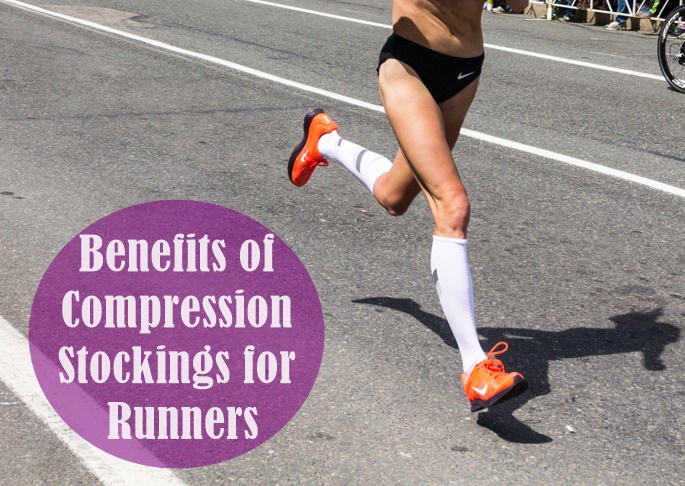I experimented with compression socks for running, and I was disappointed because they were an irritant for me. When I switched over from heel strike to forefoot running, I struggled with shin splints, so I thought I’d try compression socks to help with the shin pain, but the socks only made the pain worse.
If you are in the early stages of learning forefoot running and are experiencing shin splints or other aches and pains in the leg, or if you struggle to maintain a fast pace, you might be wondering what are the benefits of compression stockings?
The answer is compression socks for runners don’t work, they are poorly associated with improvements in running economy and mechanical efficiency.
Benefits of Compression Stockings for Runners
A new study by Stickford et al., (2015) found that runner compression socks did not improve running economy in highly trained runners (1500 m to 10,000 m specialists). The study also found that compression socks increased consistency in lower leg mechanics during repetitive power movements, suggesting that compression socks influence biomechanics by restricting range of motion.
Other experts have theorized that athletic compression socks add biomechanical support to the lower leg, resulting in greater mechanical efficiency. However, the conventional running shoe and knee braces were thought to do the same thing, until recently both are now considered as targets for causing injury and poor performance.
Restricted Blood Supply
The problem with lower leg compression socks is that they are too tight, which is not the best for the Achilles tendon, which naturally has a poor blood supply going to it.
In forefoot running, the Achilles tendon is a major energy supplier along with other muscles and tendons that support the ankle and knee. Compressing these areas during running would disrupt blood flow. But as for recovery, compression sleeves for the legs might be okay.
Lui et al., (2008) found that compression athletic socks reduced venous pooling and improved venous return, suggesting that compression socks may be better for recovery and not a performance enhancer.
Barefoot Running is Better
If you want better gait consistency with good form, barefoot running is the way you want to go.
Barefoot running allows for consistently self-selected movements that are most economical and kinematically optimal. Barefoot conditions forces a runner to maintain similar gait patterns via adjusting leg stiffness and muscle activity in a natural response to changes in surface properties.
The use compression stockings may cause a barefoot-forefoot runner to deviate away from their preferred, or ‘natural’ mechanics, resulting in decrements in movement efficiency. Therefore, compression socks may be considered an interference by potentially preventing a runner from maintaining their own, most economical running pattern.
More From Run Forefoot:
- Best Shoes for Forefoot Runners
- Best Places to Buy Vibram FiveFingers
- How to Fuel Before a Race
- How to Land Properly on Your Feet When Running
- Reasons Why Forefoot Running is Better than Heel Strike Running
References:
Bringard A, Perrey S, Belluye N. Aerobic energy cost and sensation responses during submaximal running exercise—positive effects of wearing compression tights. Int J Sports Med. 2006;27:373–378.
Cavanagh PR, Williams KR. The effect of stride length variation on oxygen uptake during distance running. Med Sci Sports Exerc. 1982;14(1):30–35.
Ferris DP, Louie M, Farley C. Running in the real world: adjusting leg stiffness for different surfaces. Proc Biol Sci. 1998;265:989–994.
Hunter I, Smith GA. Preferred and optimal stride frequency, stiffness, and economy: changes with fatigue during a 1-h high-intensity run.
Kraemer WJ, Bush JA, Bauer JA, et al. Influence of compression garments on vertical jump performance in NCAA Division I volleyball players. J Strength Cond Res. 1996;10(3):180–183.
Kemmler W, von Stengel S, Kockritz C, Mayhew J, Wassermann A, Zapf J. Effect of compression stockings on running performance in male runners. J Strength Cond Res. 2009;23(1):101–105.
Stickford et al. Lower-leg compression, running mechanics, and economy in trained distance runners. Int J Sports Physiol Perform, 2015; 10, 76-83.
Bretta Riches
BSc Neurobiology; MSc Biomechanics candidate, ultra minimalist runner & founder of RunForefoot. I was a heel striker, always injured. I was inspired by the great Tirunesh Dibaba to try forefoot running. Now, I'm injury free. This is why I launched Run Forefoot, to advocate the health & performance benefits of forefoot running and to raise awareness on the dangers of heel striking, because the world needs to know.
Latest posts by Bretta Riches (see all)
- Forefoot Running and Achilles Pain - 19/04/2024
- Does Foot Strike Really Matter in Running? YES! - 17/04/2024
- Heel Lifts Increase Injury in Runners - 16/04/2024


Leave a Reply